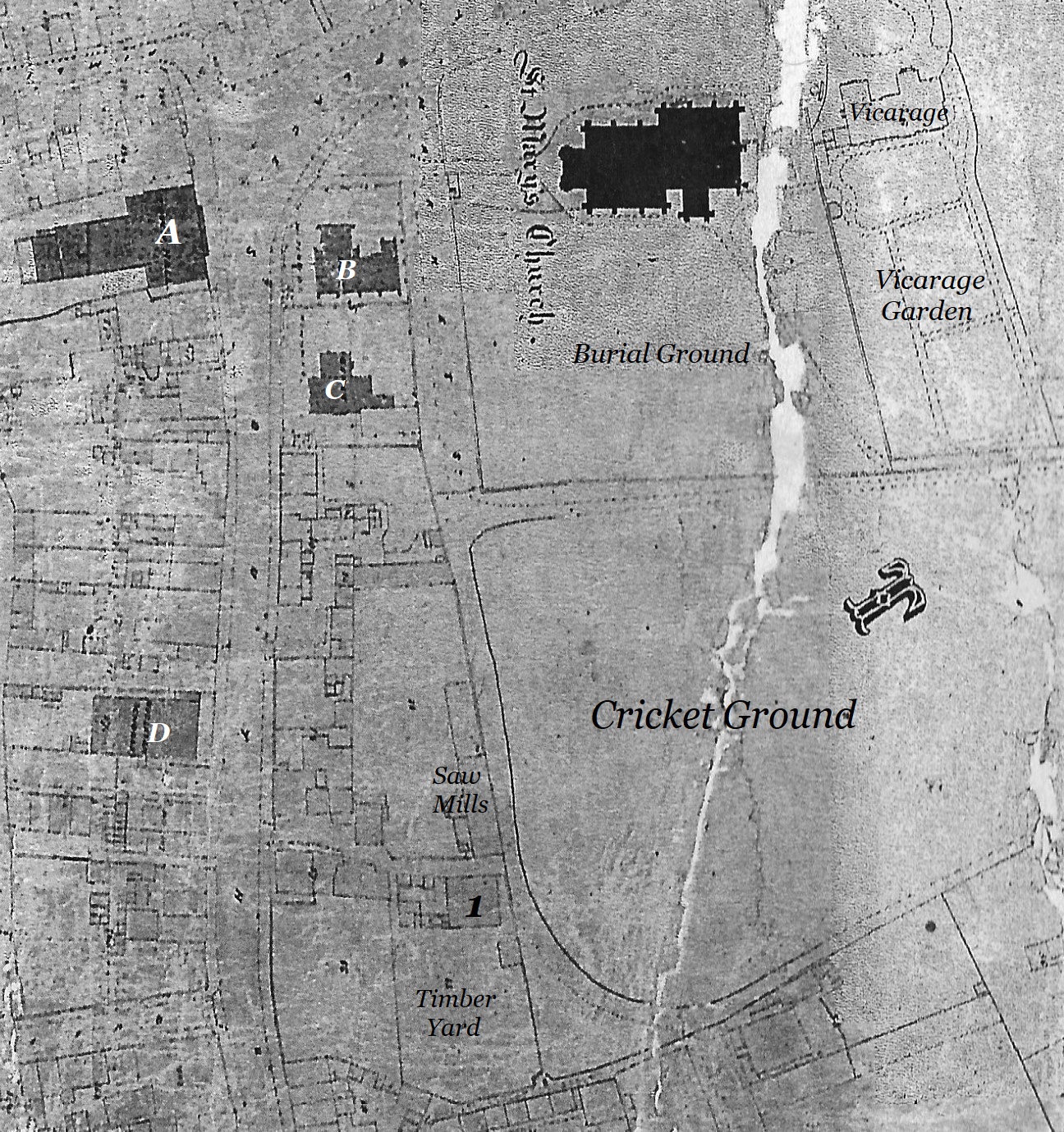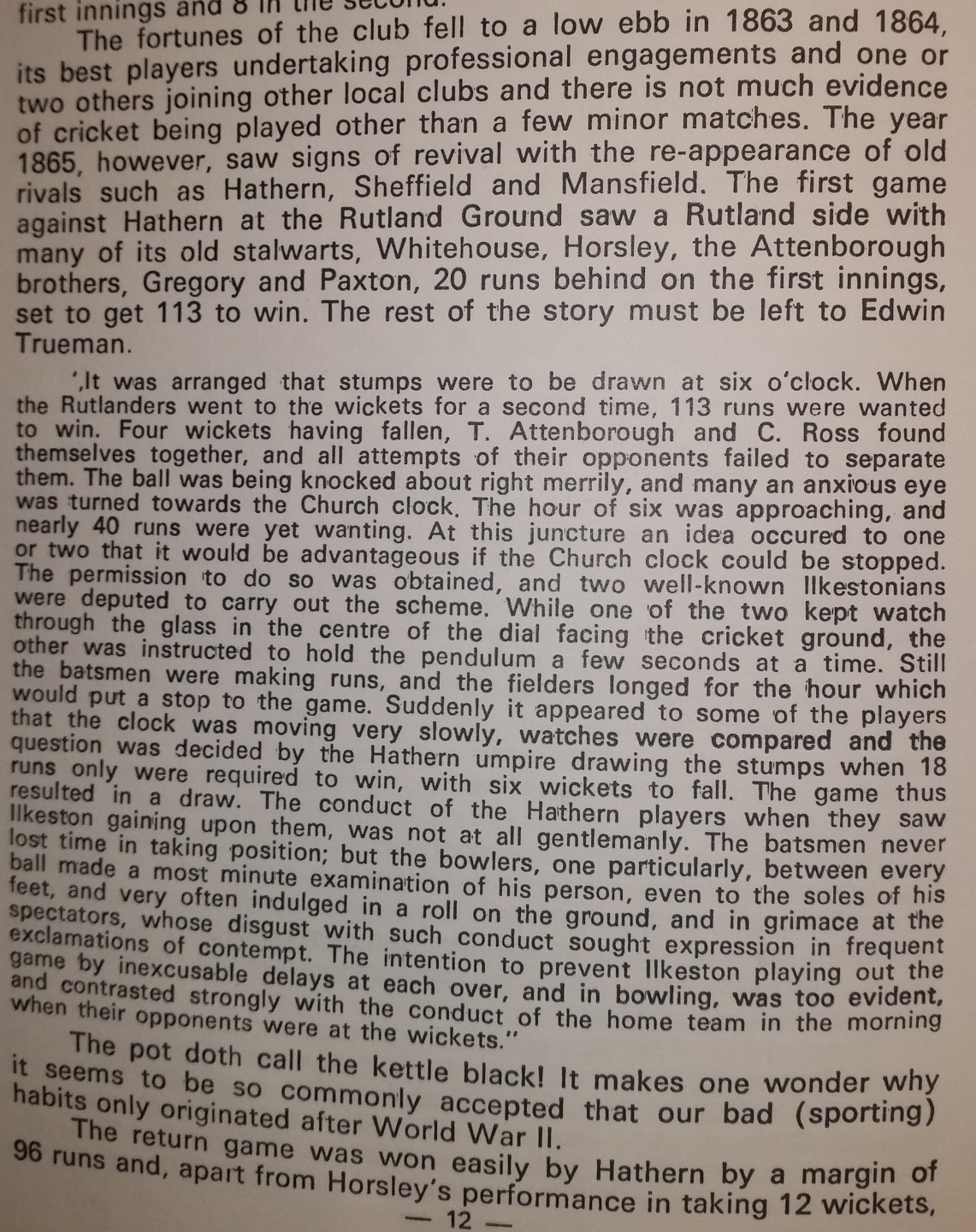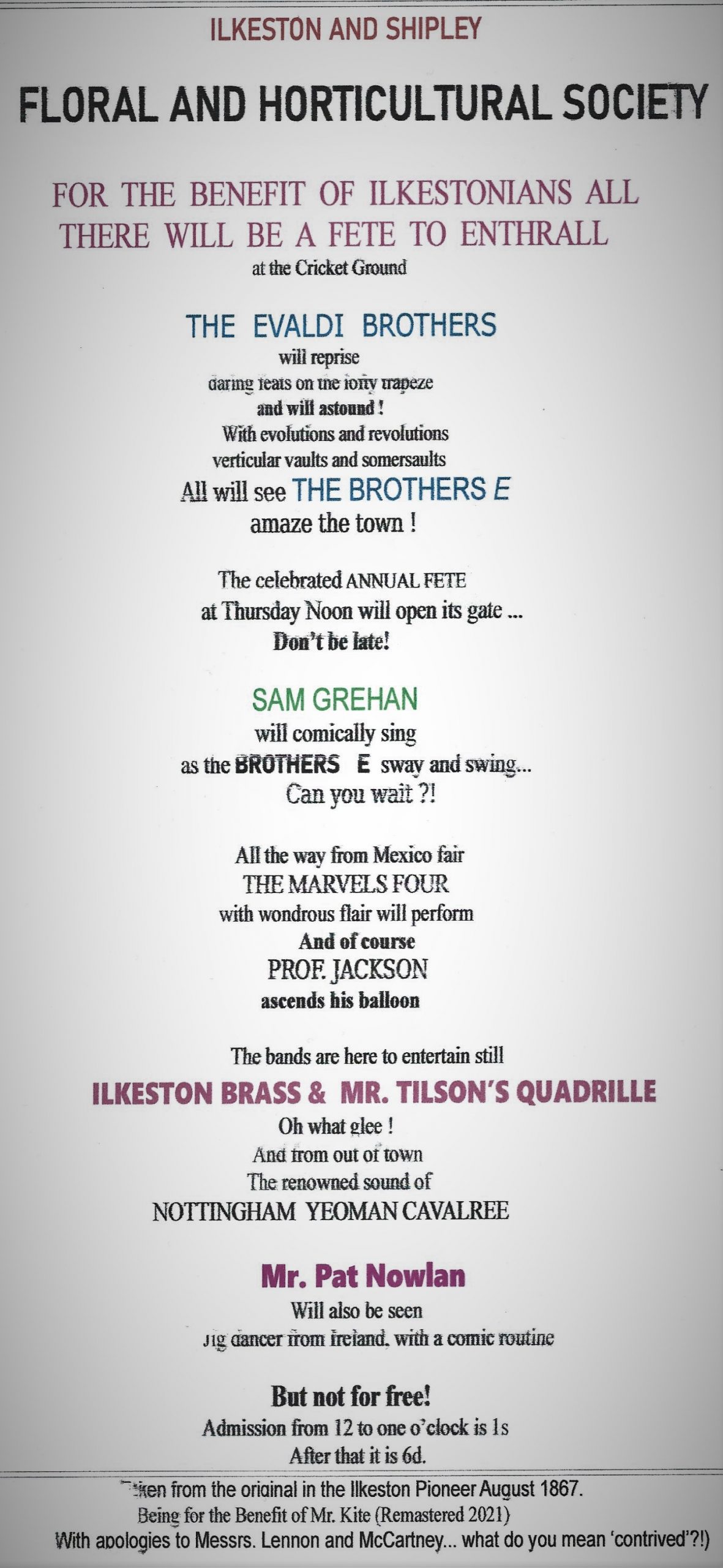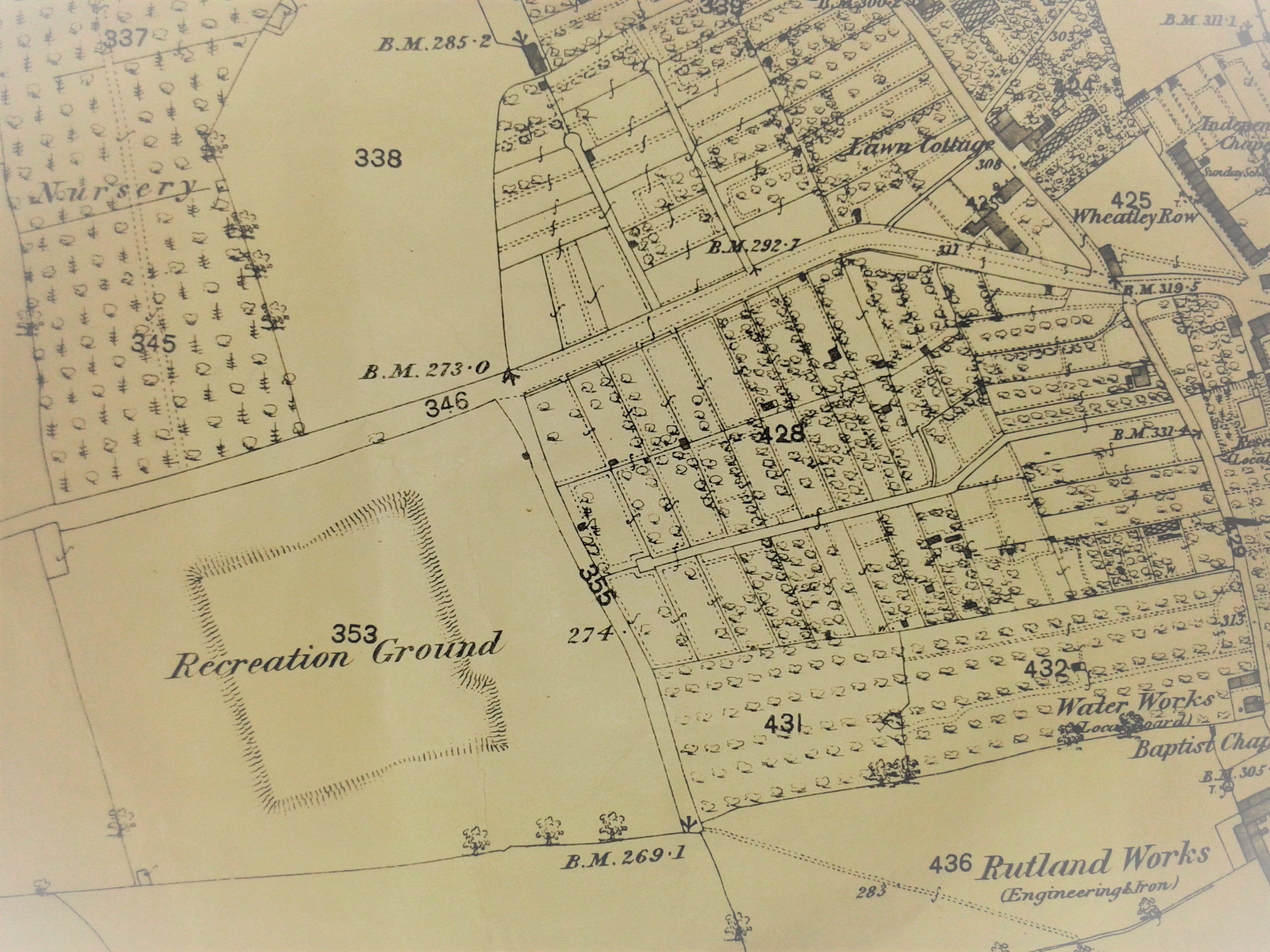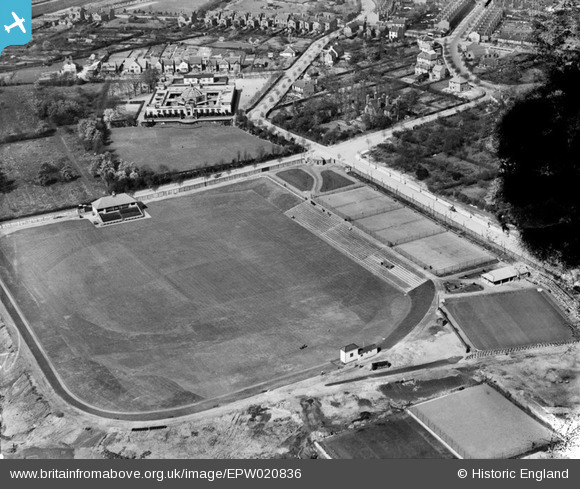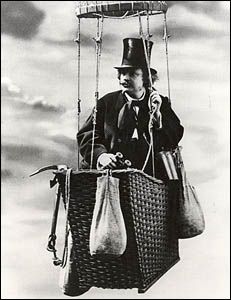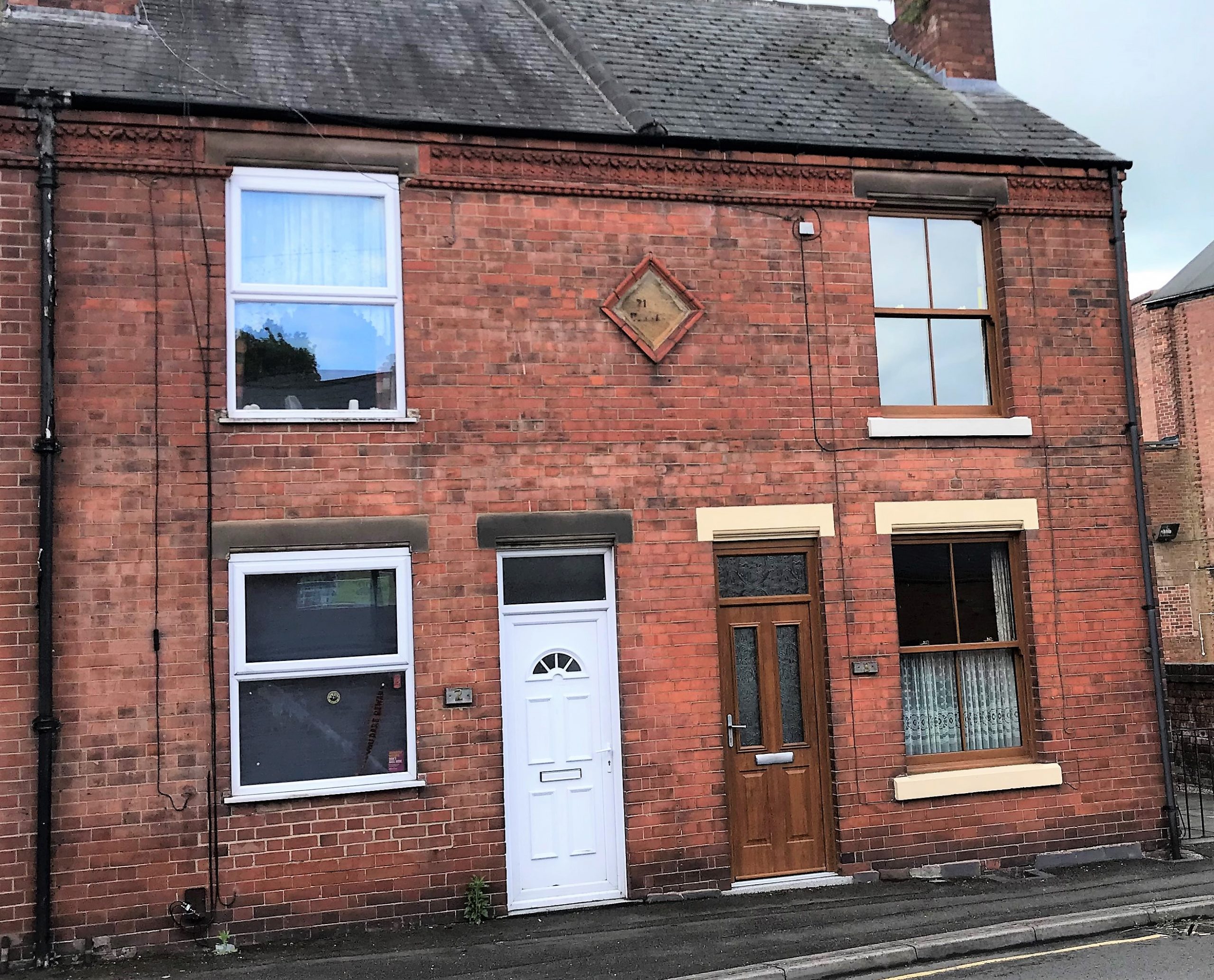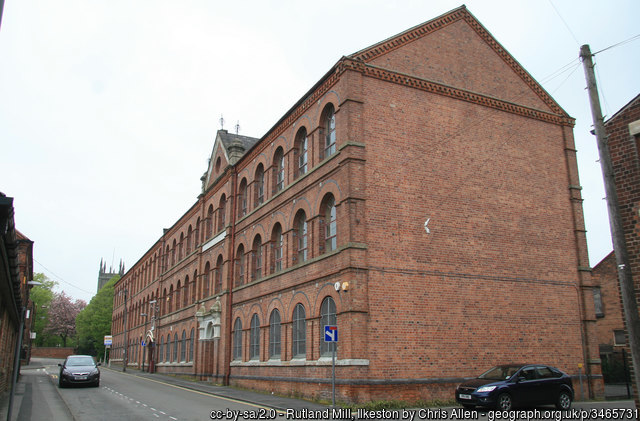The Chapel.
After Warner’s Yard Adeline leads us to “the old cricket ground Chapel, and the gates leading into the cricket ground. The old chapel stood at the top of the yard and a large gate for horse traffic and a smaller gate for the use of pedestrians divided Warner’s yard from the cricket ground.”
In a letter to the Advertiser of March 1930, Adeline recalled events in this part of town.
“The Old Chapel — now I believe a joiner’s shop — was called in those days ‘The Cricket Ground Chapel’. I was a scholar there.
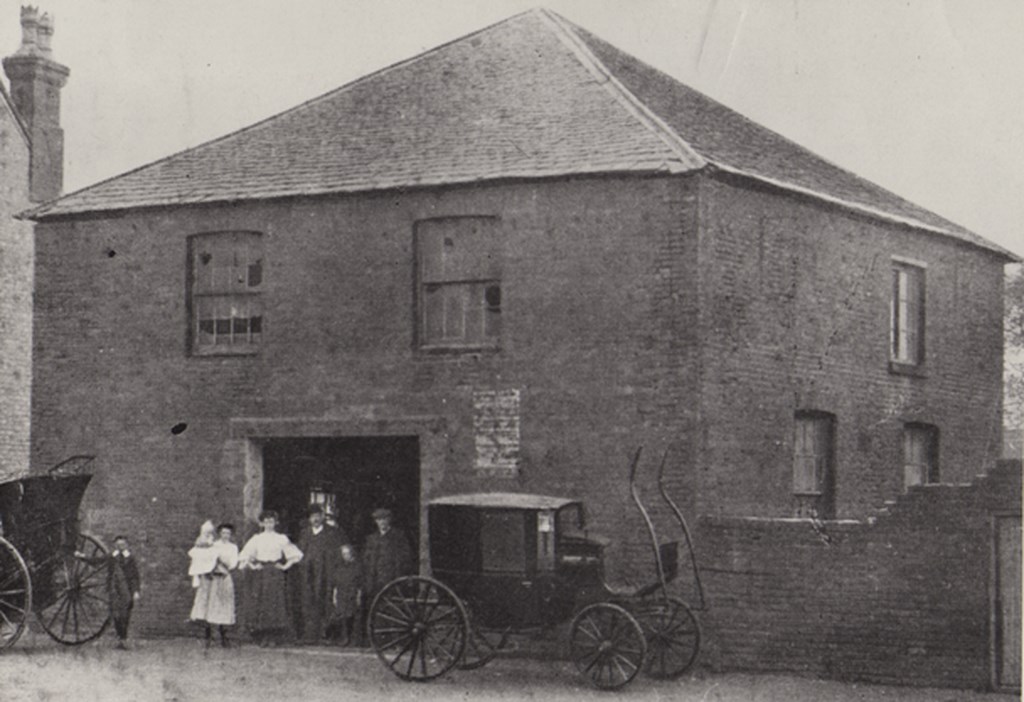 The Cricket Ground Chapel, no longer a chapel, in the early 1900s
The Cricket Ground Chapel, no longer a chapel, in the early 1900s
“On Whit-Sunday, we scholars from chapel, after morning school, would go through the gate leading from Warner’s Yard on to the path and walk in procession round the cricket ground, then back to the chapel and down Warner’s Yard into South Street, on to South Street Chapel.
“In the afternoon most of the schools assembled in the various chapels, then processions were formed and all marched on to the old ground when addresses were given by different preachers and laymen.
“The singing was a great feature, and needless to say, it was not only for the children but for everyone concerned a great day.”
Adapted from the Local Board Map of 1866
1 is the Cricket Yard Chapel : just north of it, between the Saw Mills and the Timber Yard (Warner’s Yard), is Burgin Yard. It links the Cricket Ground with South Street.
A is the Town Hall: B is the Boys’ National School, opened in 1861: C is the Girls’ National School, opened in 1851: D is the Wesleyan Sunday school-rooms, built in 1864.
In September 1884 several houses, some building land, a saw-yard and timber yard in this area of Burgin’s Yard and South Street were offered for sale. Also included was “a freehold building, formerly a chapel, now used as a joiner’s workshop by William Warner, plus copyhold land adjoining, used as a stone yard”.
Let us pause here to consider the Cricket Ground, the area around it and the activities upon it.
————————————————————————————————————————————–
The Cricket Ground.
Early Days
There is evidence that an Ilkeston cricket club was functioning in 1815 but the history of the Ilkeston Rutland Cricket Club really began in 1829 … a club which took its name from the Duke of Rutland whose family provided the three grounds on which the team has played in its history.
The first ground was a field near to Lawn Cottage down Pimlico, (close to the junction of New Lawn Road and St Mary Street) but this was used for only about nine or ten years. Then a ground to the south of St Mary’s churchyard was made available in the summer of 1839, at a reported cost of £1000, financed by the Duke – the so-called Old Cricket Ground, although some newspapers referred to it as “the New Cricket Ground“!! … and then was often referred to as “the Duke’s Ground”. The first match was scheduled for July 17th when several players from Nottinghamshire first eleven had promised to attend.
“Though rather small, it was centrally and pleasantly situated, and could afford as good a wicket as need be desired”.
In a letter to the Advertiser, dated March 28th 1930, Adeline described the Old Cricket Ground, an open space, extending from St. Mary’s churchyard to the Anchor Inn, with a walkway around it.
“The side leading from the Market Place to Market Street (that is, the west side) had low wooden palings dividing the walk from the grass. A gate and costs were at the end against the Churchyard, also again at the entrance to Market Street. It was a favourite place for children as a playground, and many a pleasant and happy hour we youngsters spent in it. Now it is a busy centre with factories, schools, houses, etc. in it. When the cricket teams were having matches we could look through or over the palings and everyone was free to walk about and see the play.”
There was a path down the wall side of Mr. Isaac Warner’s premises, which curved to the left by a cluster of trees, beneath the shade of which stood what was known as the parish pump, and let into that part of Market Street, by the Anchor Inn, the landlord of which was a Mr. Goddard. The path then continued along side this noted hostelry (in the garden of which flourished some famous poplars, as it does to this day. In the bottom corner of the ground, close by the path side, were two small hawthorn bushes into which youngsters would climb in their play. Alongside the churchyard wall was a slightly raised bank of turf, and here spectators would lounge leisurely while intently watching the progress of a match’. (Sheddie Kyme)
John Cartwright, who arrived in Ilkeston from Eastwood in 1841, recalled his early years in the town in a letter to the Pioneer in 1891.
“I remember the old mulberry tree by Ilkeston Church, and whose branches hung over the wall by the walk round the Rutland Cricket Ground. (From the Ground were pretty views of ) Cossall and its church, the woods Trowell way, Strelley and Kimberley, and Newthorpe wind mills, and the village of Awsworth; the panorama also embracing Eastwood and Greasley churches. The noble row of poplars on one side and St. Mary’s church on the opposite side….rendered Ilkeston Cricket Ground one of the prettiest in England….. How often those poplars partially sheltered we youngsters from the rays of the mid-summer sun when lounging on the turf after a game of ‘bat and ball’ in order to watch Paxton and Morris and Leivers, or the Attenboroughs and the Potters…practice the art they so much loved.
“On that same ground what fun did we have in the winter time, snowball matches between the scholars of Milner’s and Cragg’s schools, and also enjoyable football games before ‘Leagues’ and ‘professionalism’ were dreamed of.
“…on its beautiful turf I have witnessed many of England’s finest cricketers display their best form – George Parr, Joe Guy, William Clarke, (James) Grundy, Julius Caesar, (John) Wisden, Mynn, and Fuller Pilch amongst them”.
In August 1882 Edwin Trueman noted that the mulberry tree in the garden of Ilkeston Vicarage was believed to have been brought from Spain over 300 years before. “Part of the tree was recently cut away, and has been made into a piece of furniture. The wood was quite solid, and has polished beautifully”. (NG)
————————————————————————————————————————————————-
Cricket Clubs and cricket.
And what about the cricket?
An extract from a letter dated September 4th 1838 from Thomas Potter a member of the Ilkeston Rutland Cricket Club’s Committee;
“With a view of preserving order, and protecting the players from improper interruption, I have taken the liberty of stating to the Club, in order that it may be publicly made known, that the cricket ground would, I believe, be in the hands of the committee, who would be authorised to discharge all intruders, and others who do not conform to the proper rules and regulations of the club; and that the committee would expect the members of the club individually to exert themselves to prevent disorderly conduct, swearing and other indecent language, on the ground, so that neither Churchmen nor Dissenters should have occasion to complain thereof”.
“There was a period when the Ilkeston Rutland Club was able to place in the field a team which could command the respect of every opponent, and the long record of the victories won for the town a pre-eminence seldom achieved by any team drawing its members from so limited an area.
“Indeed, for several years, it was with the utmost difficulty that any club could be found to accept a challenge from our own, so certain were they that the result was a foregone conclusion”. (Trueman 3)
Sheddie Kyme recalled the halcyon days of Ilkeston’s premier sport of the first half of the nineteenth century.
“It is not pleasant to reflect that years ago Ilkeston had a cricket team which, on more than one occasion tried conclusions with the All-England eleven, and then draw a comparison of the merits of present-day players. But it is hardly to be expected that a man can become an accomplished batsman or bowler unless he has a good piece of turf on which to practice. And this, Ilkestonians have been denied ever since the old ground was utilised for building purposes. It was very generous on the part of the Duke of Rutland to give to this town, at considerable expense, the ground in Pimlico Lane, but the turf never equalled the old one, and so far as I can remember, it seemed as though a further expenditure of money was necessary to make it fit for good cricket. … It is very questionable, indeed, whether Ilkeston will ever again boast of a cricket ground to equal the old one – so conveniently situated as it was – for a nicer piece of turf could not be desired”.(IP 1908)
In the year of Queen Victoria’s coronation — 1838 — Ilkeston was described as “the earliest stronghold of Derbyshire cricketers“ “when “the old market town, with its toboggan-like street” had a cricket club. An All-England Eleven played Twenty of Derbyshire and Burton-on-Trent in 1849; the Twenty won in a single innings, largely through the artistry of John Paxton, a very fast right-hand bowler with a low delivery, who took 11 wickets for 47 runs.
At that time Bell’s Life in London (July 22nd 1849) reporting on another match at Derby, described the Ilkeston team; “the Ilkeston players, with the exception of the two Messrs. Potter, are all working men, and a more active, hardy, fearless set of young fellows are seldom seen together; independent in bearing, and civil without being servile. It is this mingling of the different classes of society in manly and friendly strife that to us constitutes the chief charm and national good of cricket, and the time is never thrown away where there is such an exchange of mutual good feeling as was exhibited on all sides in this match. Here, all were gentlemen players, for we consider every man who conducts himself respectably, and acts courteously towards his fellows, is a real gentleman, whatever his station in life”. (The two Potters were the brothers Samuel junior and Alfred, of the Old Park).
Sheddie Kyme again … “Among the cricketers who came from Ilkeston towards the end of the fifties and in the early sixties were Thomas and William Attenborough. The former was a medium pace bowler and an excellent batsman, while the latter was also a bowler and a good all-round man, both being left-handed. Thus early commenced the wonderful supply of Derbyshire left-handed bowlers”. In 1870, in a match against the Marylebone Club, Derbyshire won by four wickets, with Tom taking four wickets for eight runs in the first innings and “when runs were wanted to win Tom Attenborough carried out his bat for 29 of the 36 scored for the loss of six wickets ere the game was won by the visiting county”. (Notes taken from the Athletic News of June 1897, written by ‘Tityrus’)
Other, lesser distinguished cricketers also practiced their ‘skills’ on the Ground and sometimes got into trouble for doing so.
In May 1863 old lacemaker William Goddard, the keeper of the Cricket Ground, charged young ironstone-getter William Henson with playing cricket there without permission.
The latter was with a few mates and refused to leave the ground when old William ordered him to do so. In his own mind young William had a reasonable justification for playing there for free.
About two years earlier he had paid one year’s rent of 15s 6d for access to the ground, but then had left the town for some while, thus not getting his money’s worth.
Now he was back in town and making up for the lost time. Or so he argued.
Unfortunately for him the magistrates did not see his actions in the same way — paying a rent two years before did not entitle William to play on the ground now.
He was fined 14s with costs but refused to pay. Thus his game of cricket led to a fortnight’s residence in jail.
Frank Blasdale gives us a glipse of the state of the Ilkeston Rutland club in 1863-1864 (from Andrew Knighton’s collection)
By 1866 the Ilkeston Pioneer sensed the ‘changing of the guard‘ …
‘The “First Eleven” of Ilkeston of late years have not maintained their wonted fame as cricketers. For a long time they were the “champions” of the clubs of Derbyshire — never fearing, and seldom receiving a defeat. During the last 25 years Old King Time has drawn deep his lines in many of the well-known faces of the club, and the silvery fringe of age fittingly ornaments the heads of others whose earliest years were spent in the light-heeled mirth of “cricket”. We are not surprised to hear, therefore, that the First Eleven of the Rutland club are about to retire with their honours, to balance their accounts, and make fitting bequests to other and younger men who are emulous of the fame of the Ilkeston cricketers.
‘In chattering o’er the fund of local cricket lore, and the contests of the Rutland with All-England and distant clubs, quoting this rare “catch” and that bold “run”, the names of Samuel and Phillip Potter, Whitehouse, William and Thomas Attenborough, Paxton, Flint, Gregory, Horsley, Trueman, Ross, and others will long be foremost in the recollections of the thousands who have proudly witnessed their exploits in the field.
‘It is some gratification to know that they are succeeded by others well able to sustain the honour of Ilkeston cricketers. As an instance of this we were pleased to see, in a game played at Durham last week*, our townsman, William Rice (at present out as a professional) had obtained a most distinguished position. The match was between the married and single, played on the City ground. Rice scored 38 runs, obtaining the leger, and distancing all his mates and opponents by about 20 runs. In the first innings, as a bowler, he took four wickets, and in the second six wickets of the singles. A week or two ago we had the pleasure to record a like success on the part of Horsley; and we are sure that the friends of Ilkeston will be glad to hear such good accounts of their native townsmen in professional engagements’. (IP May 1866)
*The Durham match mentioned above took place on Whit Monday, a general holiday, and was the opening match of the season for Durham City Cricket club, a match between their married and single members. William Rice was then a professional cricketer engaged by the club and played on the ‘married’ side — although he was not married !! And his contribution was deemed to have been the determining factor in which side won this match — in his only innings he scored more than the combined total of all the batsmen of the ‘singles’ in their first innings. The latter lost the match by an innings and 3 runs. In the evening after the match the club members and friends enjoyed a good dinner at the Dun Cow Inn, where William was presented with the match ball.
In September 1866 William completed his contract with the Durham Cricket Club and was presented with a silver watch and chain, as thanks for his valued services.
In May 1869 the Cricket Ground was placed under the control of the Rutland Club by the Duke of Rutland.
In order to finance the upkeep of the ground, before playing there, every person was to pay the sum of two shillings and sixpence ‘for the season’.
Then in 1871 the Cricket Ground was enclosed by a seven-foot high wooden fence so that a small charge for admission could be made when a match was played.
This provoked many complaints such as that from letter-writer ‘Ilkestonian’ who lamented the loss to the town caused by such an unsightly barrier.
He argued that previously from the Ground he was able to see St. Mary’s church on its northern side, the new burial ground on its eastern slope, the Vicarage and Dalby House.
And then, gazing out over the vales of the Erewash and the hills of Nottinghamshire, he could view the churches of Cotmanhay, Cossall, Trowell, Strelley, Eastwood, Greasley, Stapleford, Sandiacre and Bramcote!!
He must have been a passenger with Professor Emanuel Jackson ! (see below)
“I recollect that ground before it was fenced round , when it had the appearance of a village green, the only thing lacking to make it complete being the Maypole”. (Sheddie Kyme)
But there were ways to circumvent the fence’s obstruction, as evidenced by the same writer, who ‘had a distinct recollection of witnessing a good portion of one of these games through a hole in the boards, from which a knot had very conveniently been knocked out’.
—————————————————————————————————————————————————
Parades, fetes, galas and meetings.
The Old Cricket Ground was used for many purposes other than playing cricket. It provided the venue for children’s entertainment and sports meetings, for visiting acrobatic displays, fairs and singing troupes, for brass bands and fireworks displays. And then there was the annual ‘Floral Fete’ of the Ilkeston and Shipley Floral and Horticultural Society, formed in the mid-1830’s.
The Ground was also an important meeting place. For example, on a Tuesday in July 1853, the Jubilee of the Sunday School Union, then 50 years old, was celebrated in Ilkeston.
Taking advantage of favourable summer weather, thousands of people descended on the town, by train, boat and road, from Marlpool, Kimberley, Long Eaton, Stapleford, Stanton, Loscoe, Riddings, Langley, Moorgreen, to join with the people of Ilkeston in celebration at the Cricket Ground.
“Many a young heart beat high with hope, and many an aged spirit became young with the freshness of by-gone days”. (IP)
For this special occasion a platform had been built next to the church wall, stalls were selling food, music was played by an orchestra composed of over 100 musicians on wind and string instruments, hymns were sung, buns were served and picnics eaten, and the scene was awash with school groups ‘of clean, orderly, and respectable children’ parading banners.
Shops had closed and floral wreaths were hung across East Street, at the top of Bath Street, and at the entrance to the Cricket Ground, as a welcoming arch for the visitors.
The only disappointment appears to have occurred when there was an unsuccessful attempt to send up a balloon.
It was estimated that between 10,000 and 12,000 people attended this event, including four to six thousand children.
“Although not one policeman was there, and only a few constables and friends to assist, all were peaceable and obeyed every regulation to preserve good order, which says volumes in favour of Sunday schools, when we consider that twelve thousand people were assembled within the sound of that soul-thrilling harmony”. (NR)
Ten years later the old Cricket Ground was home to another gathering.
The occasion was to mark the marriage of Edward, Prince of Wales, to Princess Alexandra of Denmark, March 10th 1863.
In the morning free bread and beef were distributed to the parish poor on that site, while in the afternoon a large congregation of children from all schools in the area plus members of Oddfellows’ lodges gathered in the same place.
Ilkeston Brass Band played, the National Anthem was sung, a procession formed and set off, two by two, filling Bath Street and backed up into the Market Place and South Street, before visiting the other main streets of the town, while the bells of St. Mary’s rang out. Flags and decorations were everywhere.
Back at school the children were treated to buns and wine, or tea and plum cake.
Balloons and balloonists at the Floral Fete
At many of these events, a regular attraction was ever-popular and self-styled ‘Midland Aeronaut’ Professor Jackson (1818-1883) and his ‘British Queen’ gas balloon.

At the ‘Floral Fete’ in August 1863, after taking almost seven hours to inflate his balloon, he quickly made “one of the most beautiful ascents ever witnessed” and it was one of his nearly 400 balloon flights.
“I took more than ordinary care in the preparation for this ascent on account of the late accident at Basford. I found the gas to be of good quality. During the ascent I despatched from the car six air balloons, so as to form a train; this I accomplished very well. I found the air very cold, so that I required my cloak. When the gas had expanded sufficiently to fill the balloon, I tried, by breathing some of it for a short time, if it would in any way affect me. I found no inconvenience.
“When I had been in the air forty minutes I came near Newstead Abbey …I attempted a descent in front, but could not succeed on account of some trees; this cost me two bags of ballast. I then tried a second time, two fields to the left of the Abbey, when I was successful. Some male servants from the Abbey, with others, came to my assistance. I was somewhat disappointed that the servants were the only occupiers. They kindly conveyed me to the Newstead station, when I took train to Nottingham, and from there to Ilkeston, where I arrived that night, highly pleased with my success”. (DM September 1863)
At that time the Abbey was the family home of William Frederick Webb, Africa explorer, big-game hunter and friend of Dr. David Livingstone — to whom we will return very shortly. (below)
Two years later – August 1865 — and the Cricket Ground and adjacent Market Place area were again hosting the annual ‘Floral Fete’.
In the town, tradesmen closed their shops at one o’clock, the Union Jack on the church tower was flying and the crowd was building up.
And what a line-up was on offer for the people!
Of course there were four spacious marquees, attracting exhibitors from several miles around to display the shrubs, flowers, plants, produce and fruit.
But all manner of entertainment was also provided to keep the crowds interested and amused.
Music was provided by the prize-winning Nottingham Sax-Tuba Band, the Nottingham Band of Hope Drum and Fife Band, Mr. Simpson’s first-class Quadrille Band, and naturally the renowned Ilkeston Brass Band.
Also appearing were the celebrated troupe of Maryland Minstrels all the way from Baltimore and performing their refined ‘Negro Melodies‘, Irish comic singer Paddy Flynn, sisters Laura and Rosina singing their amusing character duets, Little Tom alias the Great Little Wonder, singing ‘Pat the Dandy Ho !’ and other Irish comic airs, the juvenile Celebrated Ballet Troupe with its Drawing-room entertainment, and Her Shentina, the renowned Gorilla!
And, of course, Professor Emanuel Jackson was also booked. Undeterred by the boisterous wind and a downfall of rain, the intrepid balloonist made an ascent in the splendid ‘The British Queen’, at about six o’clock in the evening — eventually disappearing in the direction of Bulwell.
As if that were not enough, Professor Hotine was there to perform amazing feats of strength…. pronounced by the Press to be the cleverest Weight Performer in the World…..as well as wonderful sword feats, including Omar Pacha’s feat of cutting an apple placed in the inside of a handkerchief without injuring the handkerchief.
There were also areas for lovers of the ‘Terpsichorean Art’, Aunt Sallies, rifle galleries, merry-go-rounds, show caravans and other stalls.
Refreshments were under the ‘efficient management’ of Joseph Aldred of the Old Harrow Inn, William Jones of the Brunswick Hotel and confectioner Charles Chadwick who supplied ‘the cup that cheers but does not inebriate‘.
And all for an admission price of sixpence.
Although this was in August, the weather was dismal and damp — yet this did not deter hundreds of visitors from descending upon the town. The Midland Railway had laid on a special train from Sheffield, and for that day had offered reduced fares on journeys from Mansfield, Nottingham, Derby and a few other stations.
The culmination of the event was to have been a grand display of fireworks by Professor Chadwick but the inclement weather meant that he could not let off his elaborate fixed pieces — the audience had to be content with a lot of rockets and shells.
And another two years later — August 1867 … at the same event…..
In December 1872 Ilkeston Farmers’ Club held their annual cattle and poultry show at the Cricket Ground, “notwithstanding the fact that scarcely a dairy in the district has not been visited with the foot-and-mouth disease”.
This show was first held in 1827 at Mr. Cocker’s property at Ilkeston Manor House.
Post script on David Livingstone
David Livingstone died in May 1873 and to honour the memory of that explorer, Professor Jackson was now floating around in the ‘Livingstone’ balloon. He brought it to the Ilkeston and Shipley Floral and Horticultural Society’s Grand Fete in August of that year, but less than a week later disaster struck!!
Whilst moored at Nottingham ‘Livingstone’ broke free and embarked upon an unpiloted exploratory trip to Horncastle, about 60 miles away, where it came down safely. Almost at once it was ambushed by a wild tribe of Irish reapers who began to tear at it and trample upon it in a very savage fashion. A local farmer tried to barter with them, offering quantities of beer, to secure ‘Livingstone’s’ freedom, but by then the balloon was in a ‘deplorable condition’ with large sections being taken by the Irish raiders.
However the balloon was rescued, resuscitated, repaired and rose once more… in fact several times more !!
Dr. Livingstone featured in Ilkeston life less than two years later when Mr. Hall visited the British School in Bath Street to present his evening lecture on the Scottish Missionary’s travels – “illustrated by a large number of views in the form of a diorama” — to a “respectable and highly attentive audience”.
It appears the lecturer spoke with some authority as he had been present at the funeral of Livingstone at Westminster Abbey (April 1874) and was acquainted with a number of the Doctor’s personal friends.
“We must say that we have never heard a more instructive lecture than this one in the space of an hour”. (IP)
A new ‘Cricket Ground’.
In April 1876 the Nottinghamshire Guardian reported that the old Cricket Ground area was now assuming the appearance of a wilderness. The new National Schools had been built and the hoarding which had surrounded the old ground had been taken down. Turf was now being removed and transported to the new levelled cricket ground in Pimlico, a gift from the Duke of Rutland and at a cost of over £800.
The New Cricket Ground in 1880 (above) … and in 1928 (below)
For a time the Rutland Cricket Club played at the Old Park, courtesy of its owner, Samuel Potter, before moving to Pimlico.
For Sheddie Kyme this was the beginning of the end of the gloriously successful years of Rutland Cricket Club … “The new ground was not fit for cricket, and this was more especially noticeable after a period of drought”.
The annual exhibition of the Ilkeston and Shipley Floral and Horticultural Society also moved to the new Pimlico cricket ground. On the two days of the August Gala of 1876 the Pioneer estimated an attendance of 10,000 visitors.
At that time ‘Tatler’, in his Pioneer gossip column, reflected upon the good fortune of Ilkeston in having the Duke of Rutland for Lord of the Manor and in benefiting so much from His Grace’s generosity.
“To our children (the new Recreation Ground) will be especially welcome as a delightful playground, and as a means of rescuing hundreds from the dirt-pie and gutter form of amusement … the town must benefit from possessing what I propose should be called the Rutland Recreation Ground”.
The Committee of that Society had charge of the ground until, in the summer of 1877, it was opened to the general public.
One of the Society’s first decisions was to limit the annual floral and horticultural exhibition to one day from two.
In April 1878 Sanger’s Circus had booked a pitch for its pavilion at the Old Cricket Ground, followed on August Bank Holiday by Keith’s Circus.
At the 1879 Ilkeston and Shipley ‘Flower Show’ the Flying Professor was back once more and the Derby Daily Telegraph was not impressed: ‘Some say the Midland Aeronaut is bold and courageous, but the partition between bravery and bravado is narrow, and what Jackson calls mere pluck some would term sheer recklessness. Perhaps he considers he has a charmed life.’
And what did the Derbyshire Times and Chesterfield Herald have to write about its own intrepid townsman who ‘had been at it again’ ? …. “This week the indomitable aeronaut has brought the heart of Ilkeston into his mouth with fear. He was advertised to make an ascent at the Flower Show. The balloon was ‘the Evening Star’, doomed to be eclipsed. It appears that a brisk wind had prevailed all day, and when the hour came for Jackson to go up, the atmospheric forces were not abated. But the ropes were let go, and the balloon just cleared the spectators’ heads; then it came into violent collision with a vendor’s stall, breaking the tressles, tearing the covering of the stall, and placing Jackson in a position of peril. The balloon was secured, the gas released, and Mr. Jackson dismounted, no doubt … full of disappointment…. Luckily Mr. Jackson was unhurt. He appears to thrive upon sensation. He might wear a charmed life. Perhaps an inherent love of adventure prompts these dangerous exploits. If so, he mistakes bravado for bravery, and calls mere recklessness, pluck. … Ballooning is a fascinating pursuit. When applied to practical purposes it attains the dignity of a noble art. But the immediate connection between the art of aerostatics and of village wakes and local flower shows is not easily seen”.
In late August 1881 Emanuel was out of luck once more when he was booked to appear at the annual Ilkeston Gala and Athletic Sports held at the new Recreation Ground in Pimlico.
He was the main attraction, due to make his ascent at six o’clock in the evening, and many people made their way to the ground solely to catch a view of the event.
Ilkeston… we have a problem!! Unfortunately the Prof. had prematurely opened a valve in his balloon and allowed a large quantity of gas to escape. It was impossible now to reflate the balloon before the designated time of his ascent and the aeronaut decided to abort his mission.
This did not go down well with the assembled crowd, many of whose members became agitated and enraged, ‘and a tremendous rush was made for the prostrate monster which was seized and trampled underfoot’ amid much hooting and yelling. The intentions of the crowd were clear but — in true Western style — the policemen present formed a defensive circle around Mr. Jackson and his balloon. At one time aeronaut and balloon — now both severely deflated — were on the floor covered by the protective shield of Ilkeston’s brave constabulary while the surrounding mob attempted to smother the former in the ‘capacious folds’ of his flaccid partner.
Only with great difficulty did the police manage to restrain the onlookers from tearing the balloon to pieces — as well as its illustrious owner.
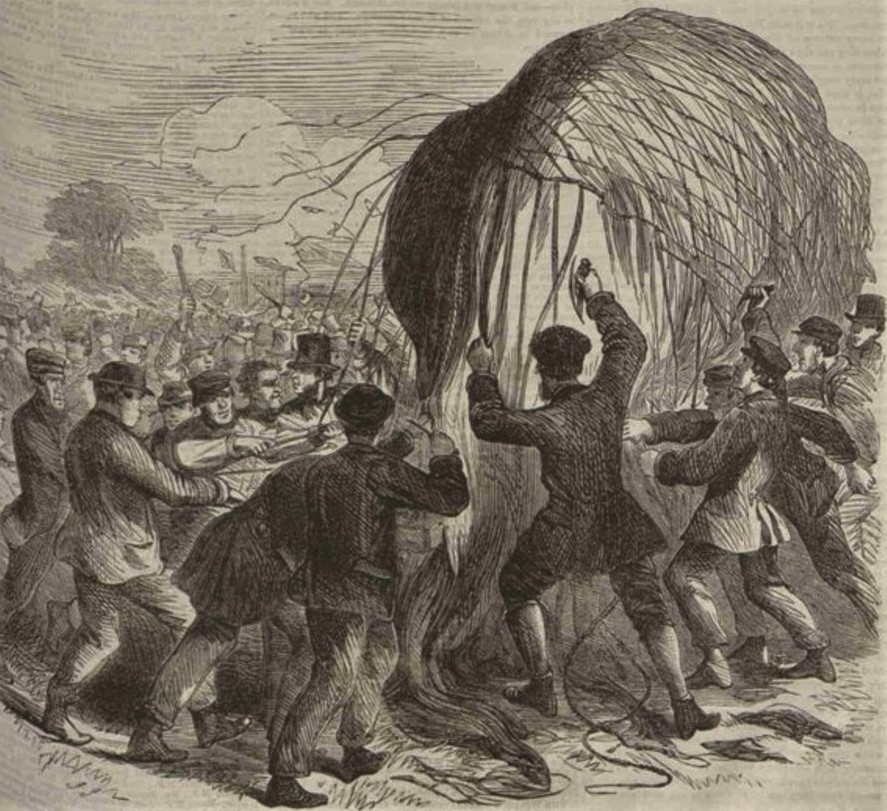
Amidst a “surging crowd of angry and excited roughs“ the Professor and balloon were dragged towards the ticket office by the attendant police, who were forced to stop frequently to repel the mob’s ringleaders. Eventually the sanctuary of the office was reached and a carriage called to transport the aeronaut to a more secure location.
Needless to state — but I’ll state it anyway — Professor Jackson was not impressed by his treatment at the hands of the irate Ilkeston mob, made up mainly of colliers. Never in his aeronautical experience had he encountered such treatment or hostility, and only the timely intervention of the law had rescued his balloon to fly once more.
However the Professor did have ‘form; this was not the first time that he had disappointed an Ilkeston crowd and this might have accounted for the ‘outbreak of popular vindictiveness’ on this occasion.
More sedate events at this Gala included handicap flat and hurdle races, a sack race, a running high jump and long jump, throwing the cricket ball, a one-mile bicycle race, and donkey and pony races.
Professor Emanuel Jackson died at Derby in 1883 in tragic circumstances but his ballooning dynasty lived on, with sons Frederick and Emanuel junior, the former now adopting the mantle of “Midland Counties Aeronaut”. Like his father, he was booked to entertain the patrons of Ilkeston Flower Shaw, and duly arrived at the Pimlico Ground on August 1st 1892 with his balloon ‘Victoria’. It was being filled with gas supplied by the Ilkeston Gas Works, but when the time for the ascent arrived, the gas pressure was proving insufficient (as later Press reports stated) and the balloon was only half full. Frederick struggled on, but after a delay of 30 minutes, he was advised to let his ‘Victoria’ go free, or else incur the wrath of an increasingly impatient and potentially violent mob of spectators.
So, at seven o’clock in the evening, without any passengers, it’s basket or any weights, the balloon was released, rose sufficiently to escape the recreation ground but struggled to progress much further. After limping on for about 400 yards, it was caught in a telegraph wire on the Great Northern branch line to Stanton and immediately burst. It had been followed by a gang of youths and men who arrived almost immediately and tore the balloon to ribbons before the remnants were brought back to a forlorn Professor Jackson; he estimated his loss at £100.
A few days later, as stated in the minutes of the Town Council meetings, the Town Clerk denied that the gas supplied by the town’s Gas Works was of insufficient pressure; Professor Jackson’s balloon had the volume of gas that it had needed !! The Press should take note !!
At Bramcote, just over a week later, Frederick lost a second, relatively new, balloon in a similar accident, when it collided with the Board Schools at the village.
Ten years after Professor Jackson death — on August 7th, 1893 — the Ilkeston Floral and Horticultural Society was continuing to hold its annual exhibition on the Pimlico Ground, an event attended by 8000 spectators, although many of them had come to hear the Brass bands of the Borough and of Cossall Colliery, and experience a variety of outdoor entertainment …. and to witness another balloon flight, this one by Captain Orton, who was there on a “no ascent no pay” basis. He was determined that his would be no abortive attempt and so started filling his balloon at 7 o’clock in the morning … but once more the gas supply let the aeronaut down (though the Captain did promise his attempt would be renewed the next day). “In other towns four or five hours is enough to inflate a balloon, but in Ilkeston the gas believes in making haste slowly“.
Fortunately for the Captain, the crowd was much better behaved than in previous years, and he ‘escaped’ without a scratch !!
Over 40,000 feet of gas had been supplied by Ilkeston’s Gas Company, in vain, to try to inflate the wretched balloon and the Town Council’s Gas Committee refused to rebate any of the cost of this gas supply. It wasn’t the fault of the supply, it’s members argued … it was because the balloon had not been varnished, a fact which Captain Orton admitted.
A month later — and the balloon Victoria had now been varnished !! — Captain Orton made a successful ascent at the Shipley and Cotmanhay Floral and Horticultural Society’s annual fete when, in calm and benign conditions he ascended, to be two miles from the exhibition ground, having travelled over Ilkeston. “The plucky voyager of the air ascended swiftly yet steadily into the realms of space. The silken monster gradually rose to a tremendous height and slowly drifted over Ilkeston. (Did the people there ponder on what they had missed the month before ??). After what seemed an interminable period of waiting, the little figure just discernable at the bottom of the fast vanishing balloon was seen to part company with it, and after a fall of a few seconds the parachute opened out beautifully, and slowly but surely the Captain sank to the ground, dropping on the cinder tip at Stanton Ironworks, and slightly grazing his face and wrist. Captain Orton subsequently drove back to Ilkeston. His balloon, when he left it disappeared into the clouds, and only an occasional glimpse of it was seen for a few moments, when it finally vanished from sight, to come to the ground doubtless some miles away”. (Belper and Alfreton Chronicle, Sep 8th 1893).
The Pimlico Recreation Ground was still owned by the Duke of Rutland and despite the fact that the new Town Council discussed leasing it in 1888, and then a few times thereafter … it wasn’t until 1914 that it became the property of the town. It was kindly gifted to the town by the Duke of Rutland to commemorate the visit of King George V and Queen Mary to Ilkeston in that year.
1888: The Ilkeston Cricket Council
The Council was developed in the late 1880s in an effort to restore to the town its former cricketing glory. Alderman William Tatham accepted the presidency of the Council while its secretary was George Barratt Hargreaves, master of Granby Board School.
Its aims were set out by George in a circular ….
1. to promote a more cordial feeling amongst the different clubs of the town.
2. to encourage and develop the cricket of the town, especially amongst the younger players who show aptitude for the game.
3. to aid in improving the ground and make it worthy of the town.
4. to get in touch, if possible, with the County Committee, for the purpose of recommending deserving players.
5. to play a few good matches each year: the Ilkeston team to be thoroughly representative; and to include the picked players of the town.
6. to endeavour, if possible, to regain the cricket renown which this town at one time deservedly enjoyed.
At a Smoking Concert, held at the Town Hall in May 1896, to raise funds for the Rutland Cricket Club, William Fletcher, chemist of Bath Street, stood to speak about his experience with the club. He had come to Ilkeston 28 years ago and had been a member and supporter of the club for over 25 years; he was now hoping that they could bring back the days when the Rutland Club was second to none in the county. William also referred to past comments about the poor state of the Pimlico ground, and assured players that, as a member of the Grounds Committee, everything would be done to make it one of the very best in Derbyshire. On his last visit there he had found it in better condition than it had ever been before — perhaps he would say that, wouldn’t he ?
———————————————————————————————————————————
The Good Old Days
A reminder of the Old Cricket Ground and its situation lies in the name attached (now faded) to this group of houses in Coronation Street — Cricket Terrace
Cricket Terrace in 2022
Reminiscing in 1901, Alderman Sudbury remarked that the old Cricket Ground used to be where his own factory now stood. The building of this factory, belonging to Messrs. Charles and Francis Sudbury, glove and hosiery manufacturers, was begun about September 1880 and undertaken by William Warner.
“The factory is built of red brick beneath a slate roof. The principal building is three storeys tall and twelve bays long. The two centre bays are framed by pilasters and contain an elaborate doorcase. All windows have semi-circular heads. Francis Sudbury JP and his son Charles Sudbury JP were both mayors of Ilkeston. George Maltby JP, a relation by marriage, rented part of the factory for lace manufacture at the turn of the century”. (Erewash Borough Council List of Buildings of Local Interest )
In August 1881, while the factory was under construction, William was warned that a gang of lads was attempting to pull down the scaffolding erected around the building works.
He left his nearby home – and his dinner – to rush to the Cricket Ground where he discovered that the lads had grabbed a pully rope in an effort to dislodge the scaffolding. A pole had been broken and the scaffold loosened.
This was not the first time that such juveniles had given him trouble there and delayed his work.
Talking to them had proved futile — they needed to be taught a stern lesson, preferably by the law — and so he took them to court.
But the lads had hired ‘a brief’ who skilfully tried to show that the builder was at fault!!
William had been negligent in not erecting a fence around the partially complete building as the law required. The boys had just come out of school and merely pulled on the rope as a prank, with no malicious intent.
The magistrates pondered – and pondered – but could not agree on whether the actions of the lads were ‘malicious’ as defined by the law. So they could not convict.
One of the gang of lads was future Mayor of Ilkeston 12-year-old Horace Moss, son of South Street pawnbroker John and Mary (nee Scattergood).
Town amusements.
“Amusements were very few. There would be a party or two at friends’ houses at Christmas time, and perhaps a concert in the Cricket Ground chapel…. but it rested on the mother to keep her children interested and entertained during the long dark winter evenings”. (Adeline)
Born in 1864, writing in 1933 about life in the 1870’s, Richard Benjamin Hithersay agreed with Adeline’s short assessment.
The monotony in the town would be broken by the annual Flower Show, the ‘Wakes’ and the ‘Statutes’, outings associated with religious bodies and an occasional concert in the Town Hall, though the ‘busy and often rowdy’ Market at the end of the week offered a welcome change to many.
‘Those who wanted music-halls, theatres, or ‘life’, as it is generally understood, had to go to Nottingham or Derby to gratify their aspirations. Cheap railway return tickets on the market days of these respective places enabled them to do so at small cost for transport, and the exodus from Ilkeston on these occasions was always very big’.
Amusement centres of occasional attraction included the Old Harrow Inn yard, Woodroffe’s Croft, the ‘Junction’ and the Cricket Ground.
In September 1893, Henry Vincent Clarke was granted permission by the magistrates to build a theatre on Rutland Street to accommodate 1200 persons, to be made of wood, and to be opened on November 13th.
Close by, Burgin’s Yard and Row. Grand Tour

